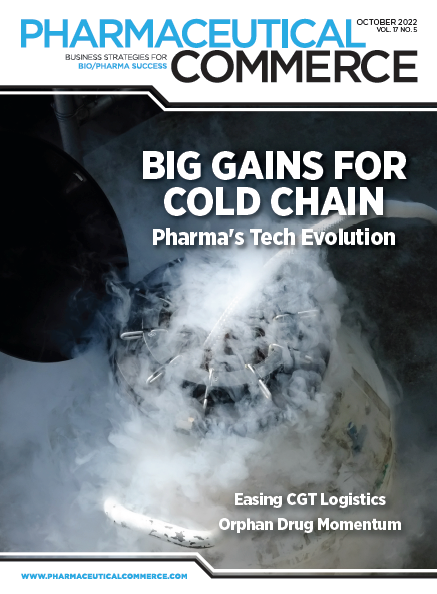Betting the House on Orphan Drugs
While all drug development efforts are fraught with peril, a growing number of biopharma companies—large and small—are staking a claim in the rare disease treatment space, chasing odds that could yield clinical and financial rewards
By definition, in the US, a rare disease is defined as one that occurs in 200,000 or fewer people. In the EU, the classification is any condition that has a prevalence of one in 2,000 or less. While the incidence rate for any given rare disease is small, the numbers add up quickly in terms of overall prevalence. Today, more than 400 million people worldwide, and 30 million people in the US are affected by one of the nearly 10,900 rare diseases that have been identified to date, according to advocacy group RareX.1 Unfortunately, less than 10% of all such diseases have an FDA-approved treatment, according to the National Organization for Rare Disorders (NORD).
In the US, the Orphan Drug Act (ODA) of 1983 is widely heralded for spurring ongoing innovation in rare diseases that may have otherwise not garnered attention by offering lucrative incentives to drive innovation and reduce risk for drug developers. These include:
- Tax credits for qualified clinical testing
- Qualification for expedited development programs
- Waiver of the Prescription Drug User Fee (which can be several million dollars for a new drug)
- The opportunity for the drug to receive seven years of market exclusivity
- Exclusion from the Pediatric Research Equity Act
Prior to 1983, only 38 orphan drugs had received regulatory approval. In the nearly four decades that have followed since the ODA went into effect, nearly 1,090 orphan drugs have been approved in the US.
Interestingly, thanks to sustained effort among small- and large-sized biopharmaceutical companies, in 2020, more than half of all new molecular entity (NME) and biological approvals by FDA were for treatments aimed at rare diseases, notes Tim Coté, CEO of Only Orphans Coté LLC, a consultancy focusing on drug development for rare diseases. Worldwide, orphan drug sales were forecast to grow at a compound annual growth rate of 12.3% from 2019 to 2024—nearly double the rate projected for the non-orphan drug market.2
Many consider the path carved by the ODA to be an unqualified success. “You can’t argue with success,” says Coté. “Today, almost all countries have legislation to spur innovation in rare diseases that is modeled after the ODA.”
“The majority of rare diseases are now recognized to have genetic drivers, and tremendous scientific advances are being made in understanding genomic drivers and molecular pathways and mechanisms through which diseases occur and progress,” adds Animesh Arun, principal, rare diseases insights, for Axtria, a cloud software and data analytics company. “Such breakthroughs are making it possible to identify very specific therapeutic targets during drug development, and open the door for more specific diagnostic testing options and protocols to help patients with these genetic mutations or biomarkers to be identified more quickly.”
The shifting sands of ‘market exclusivity’
Under the ODA, one of the most important incentives for drug developers has been the seven-year period of market exclusivity that is provided for first-in-class orphan products upon approval. However, in recent years, the definition of which products will actually be protected under this exclusivity clause has grown murky.
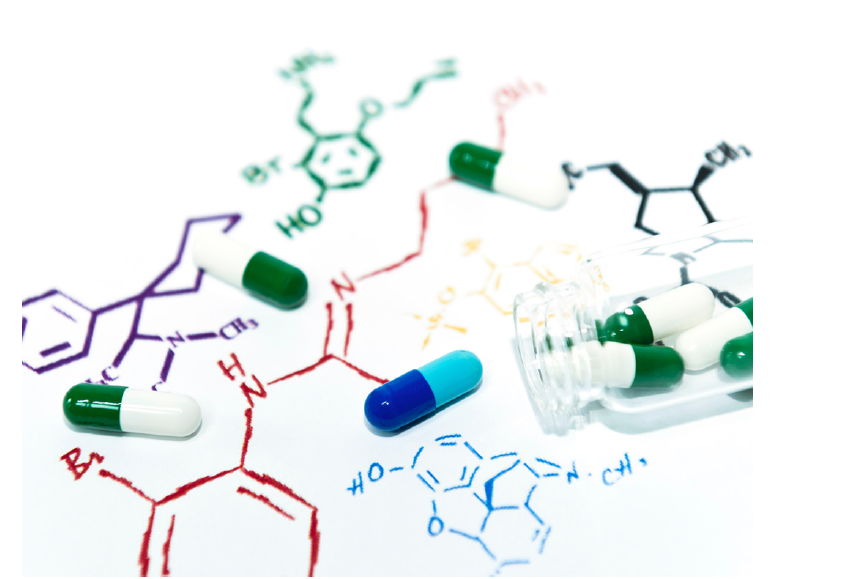
“Drug law hinges on the question of ‘what’s the same and what’s different?’” says Coté. “Under the ODA, this concept has very different implications compared to how ‘same’ and ‘different’ are considered in the review division.” From 2007 to 2011, Coté was the director of the Office of Orphan Product Development for FDA, and personally signed off on 1,400 orphan-drug designation applications in that role.
Coté explains: “While esters and salts of the same therapy may be deemed the same product, things become less clear when it comes to monoclonal antibodies, gene therapies, enzyme therapies, and the microbiome—all of which are being explored to address rare diseases; so case law is evolving very rapidly to keep up with competing claims related to market exclusivity provisions.”
For instance, today, you can get an orphan drug approved based on its moiety, “but if another drug developer comes along with a different formulation of the same moiety and it is proven to be clinically superior (in terms of being safer, more effective, or providing a major contribution to patient quality of life), it may also gain FDA approval—thereby essentially breaking the initial exclusivity provision of the ODA and instead allowing both therapies to enter the market for the same indication, viewed as being sufficiently ‘different’ despite having the same moiety,” says Coté.
Importantly, he adds that “this is not an unanticipated loophole—rather, it was an intentional aspect of the original ODA regulations, driven by the idea that if a therapy that was indeed better came along, it too could be approved to address unmet clinical need—even if it has the same moiety as the first-in-class approved therapy.”
Big Pharma takes a seat at the table
Historically, breakthrough orphan drugs have been pursued by smaller companies and startups. However, what smaller, pre-revenue life sciences R&D companies may have in the way of a winning candidate therapy and a nimble mindset they often lack in a deeper bench of expertise, experience, and funding. Thus, it should come as no surprise that in recent years, Big Pharma has turned its attention toward the orphan drug/rare disease space as well.
“Big Pharma was tentative at first because these companies understood that pursuing orphan drugs would involve a completely different business model,” says John Doyle, group vice president of health sciences at Exponent, and adjunct assistant professor in the Department of Epidemiology, Mailman School of Public Health, at Columbia University. “However, much of the low-hanging fruit in mass markets has already been harvested, yet orphan and rare opportunities still enable value-based pricing power.”
Similarly, “market saturation across most larger disease states creates considerable competition for patients, and this creates a particular challenge for drug companies—beyond even the initial challenge of getting a new medication approved for use in a crowded therapeutic space,” adds Maria Kirsch, general manager of patient services for EVERSANA.
Larger pharma companies have more stable footing to operate in the clinical trial, or pre-revenue phase longer, and absorb potential downturns—and in some cases, are able to give life to promising yet abandoned programs or molecules shelved by smaller companies, according to Ela Lourido, vice president of biopharma services for Biologics by McKesson, an independent specialty pharmacy. “And when larger companies collaborate with smaller innovator companies through license agreements and other funding or partnering arrangements or acquisitions, it can provide momentum for all stakeholders,” she says.
“Similarly, a large pharmaceutical company that has previously navigated the clinical development process multiple times will have a clear advantage compared to one doing it for the first time,” adds Scott Swain, director of regulatory sciences and real-world evidence (RWE) for Cardinal Health. “Smaller biotech companies often rely on multiple rounds of fundraising, which can delay research and development, an issue which is much less problematic for Big Pharma.”
Nevertheless, encompassing both segments, Amanda Powers-Han, chief marketing officer for Greater Than One (GTO), a marketing agency with specialized expertise in rare diseases, notes that about half of GTO’s book of business is dedicated to orphan drugs for rare indications.
“The optimist in me believes that Big Pharma and the overall industry is investing more heavily in orphan drugs for the promise they provide for better health outcomes, but they also don’t really have a choice,” she says. “Gone are the days of the big blockbuster drugs targeted at millions of patients that can provide one cash cow to help fuel the company’s fortunes.”
Growing interest in orphan indications is also a natural consequence of the industry's improved understanding of the pathophysiology of disease, notes Swain.
“As the precision medicine wave has helped to redefine specific forms of any given disease as rare, and identify potential treatments as orphan drugs, Big Pharma had no choice but to grab a board and surf the waves,” he says.
RWE to augment accelerated approvals
The role of RWE derived from analysis of and formal studies involving real-world data (RWD)—such as electronic health record (EHR) and claims databases, published literature, laboratory testing and prescription data, patient-reported outcomes, registries, digital health, and wearable device data and more—to support the orphan drug space continues to become more multifaceted. RWE-based efforts are now being used to support drug discovery, patient diagnosis, clinical trial enrollment, and postmarketing studies to confirm longer-term clinical outcomes when an orphan drug is approved on a limited data set.
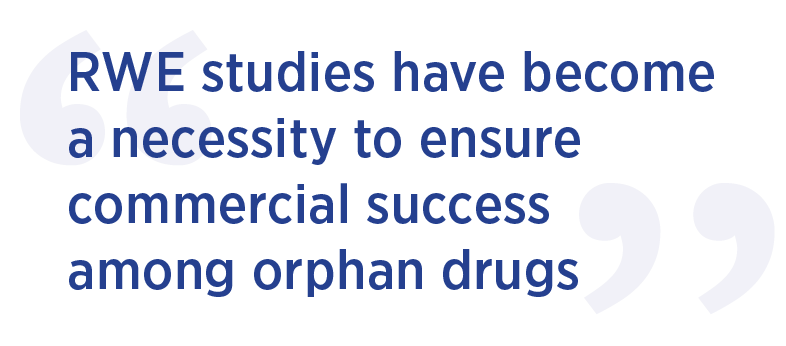
For many orphan treatments, FDA approval has often been granted on trials that involve just a small number of patients and are operated for shorter-than-usual durations, notes Ray Huml, vice president of scientific and medical strategy for Syneos Health, and head of the company’s Rare Disease Consortium. By way of example, Exondys 51 (eteplirsen) from Sarepta Therapeutics, the first therapy to receive FDA approval for the treatment of a particular form of Duchenne muscular dystrophy (DMD) that impacts just 13% of all DMD patients, only had 12 patients enrolled in the registration trial.3 “In such cases, an orphan drug could receive initial regulatory approval, but the company will then be required to carry out longer-term confirmatory studies and develop real-world evidence to confirm the clinical benefit, safety, and durability of the therapy over longer time frames,” adds Huml.
Small trial populations and expedited approval processes often translate to a dearth of clinical insights at market launch, and this can impact physician prescribing behaviors, patient acceptance, and payer coverage, Nancy Young, vice president of commercialization services on AmerisourceBergen’s global consulting team, points out. “RWE studies have become a necessity to ensure continued commercial success among orphan drugs, and to inform both clinical decision-making and coverage negotiations,” she says.
In turn, armed with this information, payers are more routinely implementing innovative strategies to address access and reimbursement issues associated with these promising yet high-cost medicines—to ensure they receive optimal value from their pharmacy spend.
"Post-marketing studies undoubtedly enable data-informed payer support, which then improves patient access to these lifesaving therapies,” contends Lourido.
Diagnosis and trial recruitment challenges
For patients with a rare disease, it can take anywhere from five to 10 years, and interactions with dozens of doctors and specialists, to get a proper diagnosis.4 “It’s important to get the diagnosis correct, and to identify relevant genetic mutations, as this can help connect the patient to a trial or approved therapy that is specified for that particular form of the disease,” says Huml. The executive speaks from experience, as he and his wife are parents to a son and a daughter each living with the rare condition facioscapulohumeral muscular dystrophy, a a disorder characterized by muscle weakness and wasting (atrophy). Huml is the editor and author of Rare Disease Drug Development: Clinical, Scientific, Patient and Caregiver Perspectives, published in 2021 by Springer.

“The sense of urgency in rare disease therapies cannot be overlooked,” adds Kirsch. “When it takes years for a patient to be diagnosed, that’s additional years of pain, struggles, and uncertainty.” Such delays not only slow down access to an approved therapy or the ability to participate in a relevant clinical trial, but for some types of rare diseases, the lost time can lead to irreversible disease progression or loss of motor skills, organ function, or cognitive capabilities.
Fortunately, as GTO’s Powers-Han points out, rapidly expanded capabilities in advanced data mining and data analytics using artificial intelligence (AI), machine learning (ML), and simulation are helping to power the process of finding needles in a haystack. These tools can connect seemingly unrelated data to identify a matrix of symptoms to help to connect the right patients with the right clinical trial opportunities more quickly.
EVERSANA’s head of data and analytics, Simon Andrews, adds: “Today, using a predictive model deployed in the technology stack, a hospital can analyze significant quantities of de-identified patient-level data, helping physicians to improve the odds of a timely, accurate diagnosis at the point of care for a particular patient, or suggesting a potential diagnosis that would then prompt the doctor to order appropriate blood or genetic testing.”
Arun of Axtria cites an example of using patient-progression modeling to identify anonymous patients that are likely to have a particular rare disease or progress in their disease. This enables timely flagging by their physicians, and can provide a critical opportunity for timely intervention and initiation of therapy, he says.
“Physicians will often wrongly assume the most likely diagnosis but rarely consider a diagnosis of a rare disease, while today’s AI/ML and advanced data-analytics techniques will do the opposite,” adds Harlen Hays, director of research analytics for Cardinal Health.
Another factor that hinders timely disease diagnosis and, in turn, clinical trial enrollment, is that today’s medical coding systems, experts agree, do not provide sufficient nuance for many rare disease categories. “Of the 10,600 rare diseases known today, only about 500 of them have formal ICD-10 codes,” notes Huml on the international classification of diseases coding system used by the US healthcare system. “If you’re mining databases in search of trial candidates or are trying to assess the potential market size for a drug, you will find some mechanistically related patients lumped together under the same code. But the apparent findings will be overinflated because you won’t be able to easily identify just the specific subset of patients you want based on a particular undifferentiated ICD-10 code.”
There is work currently underway5 to allow researchers to improve the identification of patients using claims databases without strict reliance on ICD-10 codes. “This is accomplished by leveraging the prevalence of clinical presentations clusters known to be associated with the correct phenotypes,” explains Andrews of EVERSANA.
Drug distribution: Streamlined yet complex
Due to their small overall volumes, nearly all rare disease medicines are subject to an exclusive or otherwise highly limited network arrangement defined by the manufacturer prior to regulatory approval, explains McKesson’s Lourido.
“Because orphan drugs typically must be stored in temperature-controlled settings, distribution requires a white-glove mindset to ensure these expensive and low-availability products make it safely to the end patient,” adds Danny Williams, president of channel management for EVERSANA. Temperature studies, he says, should be carried out prior to transportation, and rigorous protocols should be followed to maintain these products within the required temperature range throughout storage and transportation, using specialized cold chain packaging materials and protocols.
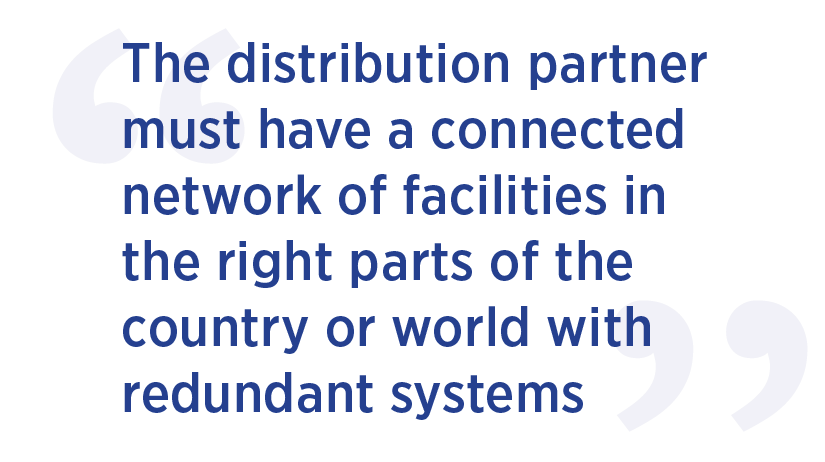
For example, because healthcare providers typically don't stock rare and orphan products for a period of time, distributors often focus on “just-in-time” shipping from a few strategic locations. “To minimize delays, the distribution partner must have a connected network of facilities in the right parts of the country or world with redundant systems to ensure continuity and swift responses in the event of a shutdown or emergency,” says Adam Blatney, vice president of specialty sourcing and distribution for AmerisourceBergen.
Similarly, the distribution partner should have established customer relationships across all classes of trade, particularly as additional drug indications are received, and have broad health system penetration. “These existing relationships increase the likelihood of timely shipping, existing credit lines accounting for the provider’s full portfolio of products, and familiarity with ordering processes, helping to ensure a more seamless customer experience at launch,” adds Blatney.
Premium pricing: Getting what you pay for
Orphan drugs are typically among the most expensive therapies on the market, with prices that can easily go from hundreds of thousands to millions of dollars per patient. Today, value-based contracts (also known as outcomes-based agreements), which aim to reduce risk by linking payer coverage directly to actual clinical outcomes, continue to grow in popularity, and many stakeholders agree that they make particularly good sense in the orphan drug sphere.
While such agreements among biopharma companies, payers, and others offer a promising option to share risk more equitably, creating them produces yet another challenging hurdle for drug developers, argues Doyle.
“All parties must decide what are the most essential metrics, endpoints, or surrogate endpoints to demonstrate clinical success, and then carry out modeling and simulation (i.e., epidemiological, actuarial, economic), collecting and analyzing many forms of RWD to design the novel contract terms and manage them over time.”
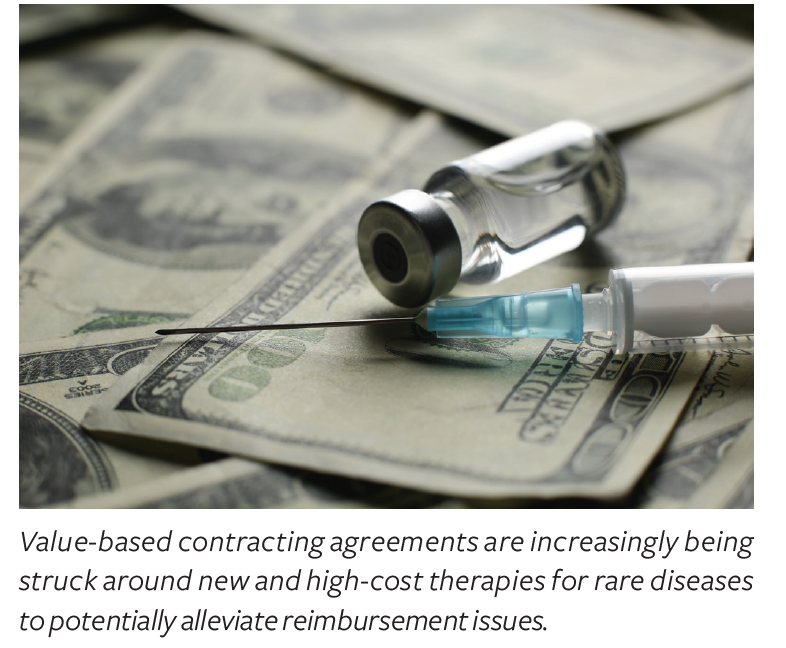
One recent example is the gene therapy Zynteglo, also known as beti-cel, from Bluebird Bio, a one-time treatment for the rare blood disorder transfusion-dependent beta-thalassemia (TDT). The condition afflicts about 1,500 patients in the US, and the lifetime cost of caring for a patient with TDT can eclipse $6 million, according to the company.
Prior to the drug’s US approval in August, the Institute for Clinical and Economic Review (ICER) “unanimously determined that evidence is adequate to demonstrate that beti-cel provides a net health benefit compared to standard clinical management based on an anticipated (pre-approval) price of $2.1 million—as long as the price is subject to 80% payback for patients who do not achieve and maintain transfusion independence over a five-year period.”6
When the therapy entered the market this summer, Bluebird Bio set the average wholesale acquisition cost (WAC) of $2.8 million per patient—a price the company says reflects the potentially curative nature of the drug and its ability to reduce the need for a lifetime of blood transfusions in 89% of Zynteglo patients.7 To help model risk-sharing arrangements among drug developers and payers, Doyle notes that Bluebird Bio shared publicly an outcomes-based contracting strategy featuring a one-time, up-front payment with a potential rebate up to 80% of that one-time therapy cost if patients don’t achieve transfusion independence. Specifically, the company is offering payers an outcomes-based deal that would refund up to 80% of Zynteglo’s cost if a patient fails to achieve and maintain blood transfusion independence up to two years after infusion.8,9
Alnylam Pharmaceuticals has also devised an outcomes-based contract with certain payers for Onpattro (patisiran), its orphan drug for the treatment of polyneuropathy caused by the rare condition HATTR amyloidosis, to soften the blow of the drug’s $445,000/year WAC. The value-based agreement for Onpattro with pharmacy benefits manager Prime Therapeutics allows for a refund in the event that one of two endpoints is triggered—drug continuation by the physician or progression to liver transplant.
“If you are able to generate the evidence to support the value of your product, you’ll be paid an adequate return on your investment, but I can’t underscore enough how important it is to demonstrate value in many ways, especially in this era when drug developers are often being attacked for drug pricing,” says Doyle.
Best practices in commercialization
By design, the commercialization strategy for orphan drugs must be inherently patient-centric and high touch. More so than in other disease states or drug categories, “the drug developer must function as an ‘ecosystem integrator’—creating the backbone for the many types of support programs, providing the technology and the data science that is needed for it to all work seamlessly,” says Doyle. He notes that this may include not only clinical and financial support, but programs related to nutrition, transportation, social service, and other environmental elements that will improve the long-term outcomes for such patients; this is a new strategy for many pharma companies, according to Doyle.
"It’s expensive to find the right people and build infrastructure needed to support any launch, especially a rare one,” adds Kirsch. “In most instances, it doesn’t make sense to build a pharmacy or distribution center, so it’s critical to invest in a third-party partner that can do that for you, and one that knows the industry.”
To increase the odds of success during the clinical trial process, stakeholders agree that orphan drug developers, no matter the size, should foster a strong working relationship with FDA as early as possible—well in advance of the regulatory drug filing.
“So many pharma companies are terrified of the agency, and this creates a serious obstacle in terms of both missed opportunities to streamline the process earlier, and analysis paralysis that could be overcome with a few good conversations early on,” says Coté, as noted, himself a former FDA official in the orphan drug space. “There’s no such thing as a bad meeting. The agency is honestly and earnestly looking for ways to help drug developers bring their lifesaving therapies to market as quickly as possible.”
References
1. RareX, The Power of Being Counted. https://rare-x.org/case-studies/the-power-of-being-counted/
2. Evaluate Pharma, Orphan Drug Report 2019, 6th Ed., April 2019. https://www.evaluate.com/thought-leadership/pharma/evaluatepharma-orphan-drug-report-2019
3. “Controversy Surrounds Exondys 51 Approval: What to Know,” Managed Healthcare Executive, August 2017. https://www.managedhealthcareexecutive.com/view/controversy-surrounds-exondys-51-approval-what-know
4. Huml, R.A. et al., “Use of Big Data to Aid Patient Recruitment for Clinical Trials Involving Biosimilars and Rare Diseases,” Ther Innov Regul Sci, DOI 10.1007/s43441-019-00009-1.
5. Ainslie Tisdale et al., “The IDeaS initiative: pilot study to assess the impact of rare diseases on patients and healthcare systems,” Orphanet J Rare Dis. https://doi.org/10.1186/s13023-021-02061-3
6. ICER Publishes Final Evidence Report and Policy Recommendations on Beti-Cel Gene Therapy for Beta Thalassemia, ICER Press Release, July 2022. https://icer.org/news-insights/press-releases/icer-publishes-final-evidence-report-and-policy-recommendations-on-beti-cel-gene-therapy-for-beta-thalassemia/
7. Iskowitz, Marc, “Bluebird’s $2.8M gene therapy opens the door to pricing questions,” Medical Marketing and Media, August 2022. https://www.mmm-online.com/home/channel/bluebirds-2-8m-gene-therapy-opens-door-to-pricing-questions/
8. Peebles, Angelica, “The Most Expensive Drug in the US is a Rare-Disease Game Changer,” Bloomberg newsletter, August 2022. https://www.bloomberg.com/news/newsletters/2022-08-24/the-most-expensive-drug-in-the-us-is-a-rare-disease-game-changer
9. “Bluebird Bio Ends Commercial Operations in Europe,” ACH Clinical News, August 2022. https://ashpublications.org/ashclinicalnews/news/5779/Bluebird-Bio-Ends-Commercial-Operations-in-Europe
